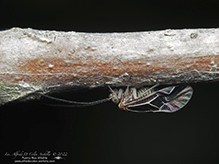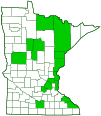tree cattle
(Cerastipsocus venosus)
Conservation • Description • Habitat • Ecology • Distribution • Taxonomy
|
|
||||||||||||||
Description |
Tree cattle is a small insect but a relatively large common barklouse. It occurs in the United States and southern Canada east of the Great Plains. It also occurs in Mexico, Central America, and the Caribbean Sea. Adults and nymphs are found on the trunks and large branches of trees. They feed on fungi, algae, dead bark, and other organic materials. They do not eat the leaves or the bark, bore into the bark, or cause any other damage to the tree. They are considered beneficial insects. They often move in a tightly packed cluster or herd. This is the feature that gives the species its common name. Adults are ¼″ to 5⁄16″ (6 to 8 mm) in length. The body is bulbous. The head is dark, round, and relatively large for the body. The forehead is swollen. The antennae are long and thread-like. They have 13 segments. The segments beyond the scape and pedicel at the base (flagellomeres) are not ringed. The mouth parts are optimized for chewing. The jaw-like inner lobes of the maxillae (lacinia) are pick-like, long and slender. They are straight, and they have a few relatively large teeth at the tip. They are used to scrape food and to prop up the head while chewing. The upper lip (labrum) has only two small projections (tubercles) inside. The maxillary palps have four segments. The labial palps have just a single oval segment, no basal segment. There are four membranous wings, two large forewings and two small hindwings. The forewings are shiny and black. They are held tent-like over the body when at rest. The pterostigma is hardened (sclerotized). It is white on the male, dark on the female. The first cubitus vein (Cu1a) is fused with the media vein (M). The last part of each leg (tarsus), corresponding to the foot, has two segments. The nymphs are dark gray. The abdomen is black with pale yellow bands. |
Size |
Total length: ¼″ to 5⁄16″ (6 to 8 mm) |
Similar Species |
Habitat |
|
Ecology |
Season |
|
Behavior |
Tree cattle do not form silken webs. |
Life Cycle |
|
Nymph Food |
Same as adults |
Adult Food |
Fungi, algae, dead bark, and other organic materials |
Distribution |
||
|
Sources |
|
| 3/31/2025 | ||
Occurrence |
||
Common |
||
Taxonomy |
|
Order |
Psocodea (barklice, booklice, and parasitic lice) |
Suborder |
Psocomorpha |
Infraorder |
Psocetae |
Family |
Psocidae (common barklice) |
Subfamily |
Psocinae |
Tribe |
Thyrsophorini |
Genus |
Cerastipsocus |
Subordinate Taxa |
|
|
|
Synonyms |
|
Cerastis mexicana Cerastis venosa Psocus gossypii Psocus gregarius Psocus magnus Psocus microphthalmus Psocus venosus |
|
Common Names |
|
tree cattle |
|
Glossary
Flagellomere
A segment of the whip-like third section of an insect antenna (flagellum).
Labrum
The upper part of the mouth, sometimes considered the lower part of the face, corresponding to the upper lip, on an insect or crustacean.
Maxillae
Paired mouth structures of arthropods located immediately behind the mandible and used for tasting and manipulating food. “Under-jaws”.
Palp
Short for pedipalp. A segmented, finger-like process of an arthropod; one is attached to each maxilla and two are attached to the labium. They function as sense organs in spiders and insects, and as weapons in scorpions. Plural: palpi or palps.
Pterostigma
The dark, blood-filled second cell at the leading edge of each wing toward the tip on many insects. It is heaver than adjacent, similar sized areas and is thought to dampen wing vibrations and signal mates. (= stigma. More precise than stigma but less often used, even by entomologists.)
Tarsus
On insects, the last two to five subdivisions of the leg, attached to the tibia; the foot. On spiders, the last segment of the leg. Plural: tarsi.
Visitor Photos |
||
Share your photo of this insect. |
||
This button not working for you? |
||
Alfredo Colon |
 |
MinnesotaSeasons.com Photos |
||
|
||
|
||

Slideshows |
|

Visitor Videos |
||
Share your video of this insect. |
||
This button not working for you? |
||
|
Other Videos |
||
Tree Cattle (Cerastipsocus venosus) |
About
Jun 17, 2023 Tree Cattle May 30, 2023, Baton Rouge, Louisiana, on cypress tree |
Herding Tiny Bark Cattle, Tree Lice 'Cerastipsocus venosus' |
About
Jul 21, 2012 It's been unusually warm this summer and these baby tree lice appear to be herding around the trunk of a sapling at the edge of a small lake in northern Wisconsin in late July. They are VERY SMALL, about 3mm, 1/8th of an inch each. Sorry about the aspect ratio, had trouble taking macro video on my camera. These little bugs eat fungi, dead bark, algae and other decomposing organic material like little tree maids. They're pretty much a tree's version of a natural tooth brush. They do not bore into the tree or harm the tree's live tissue. Watch movie to end for bug close up. |
Cerastipsocus Venosus ~ Ohio Maple Tree ~ Gold Striped Bugs |
About
Aug 18, 2019 Cerastipsocus Venosus ~ Ohio Maple Tree ~ Gold Striped Bugs |
Barklice (Cerastipsocus Venosus) Group - Beneficial Bugs Act Like a Flock of Sheep | 1080HD |
About
Aug 9, 2014 Barklice (Cerastipsocus Venosus) Group - Beneficial Bugs Act Like a Flock of Sheep. **Update: This is apparently a "herd" of a beneficial garden bug which is colloquially called a barklice. Because of the word "lice" in the name, most people quickly hate them, but apparently they are quite useful decomposer/recyclers. They feed on fungi, algae, dead bark, and other organic materials on tree trunks and large limbs. They function as “Bark Maids” to help clean the bark of undesirable inhabitants and do not feed on the leaves or the bark of the tree, nor do they damage the tree by boring into the bark. When disturbed, Cerastipsocus venosus often exhibit the fascinating behavior of temporarily scattering, much like a flock of sheep, only to rejoin again as a “herd.” Not surprisingly, they are also known as "bark cattle" or “tree cattle.” Psocoptera are an order of insects that are commonly known as booklice, barklice or barkflies. They first appeared in the Permian period, 295–248 million years ago. They are often regarded as the most primitive of the hemipteroids. Black White and Yellow Bugs in a Group - Creepy Looking Mystery Social Bugs. These are some creepy looking black, white, and yellow insects. I noticed them from my bedroom window, as a group of jittering black things on the base of the tree. With my JVC Everio GZ-EX355's 40X optical zoom, I still couldn't get a very clear picture of what was going on, so I ventured outside. I didn't really want to take the tripod outside because that area stays pretty muddy, but I just HAD to get a closer look at these crazy things. I'm glad I did. These are some of the creepiest little buggers I've ever seen. The fact that they are in a social swarm makes them creepier. At times, they make motions that remind me of a honeybee hive, with their tail shakes and seemingly erratic patterns of interacting. There are clearly males and females among the group, since some have wings and some do not. The wings are slightly transparent and most have a white dot on each wing towards the rear end. Some seem more like a pyramid body shape, while others almost look flat. The wingless ones kind of look like very large colorfully striped termites. The black and yellow striped bodies should help identify them, but I was unable to find anything with a few quick Google searches. I'll be submitting some pictures as well as a link to this video, to bugguide.net and will update the description if/when an identification is made. |

|
Created: 3/31/2025 Last Updated: © MinnesotaSeasons.com. All rights reserved. |


